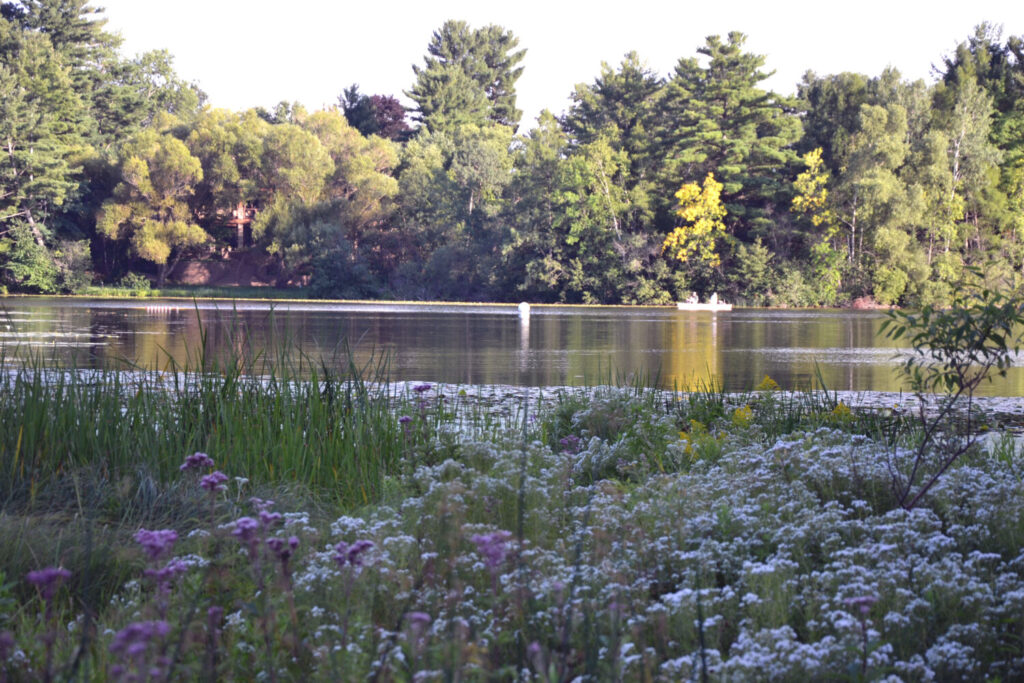
Waupaca lakes in good shape but with concerns
By James Card
The most comprehensive study ever done on Mirror and Shadow Lakes shows they are in good ecological health but there are some lingering concerns that could cause problems in the future.
At a meeting on July 14 at city hall, Todd Hanke, an aquatic ecologist, likened the survey to a physical at the doctor’s office.
Hanke works for DePere-based Onterra, a natural resource consulting firm specializing in lake management planning services.
Onterra was hired to create a comprehensive management plan for the lakes.
The project was funded by the Waupaca Inland Lakes Protection & Rehabilitation District, Friends of Mirror & Shadow Lakes and the Wisconsin Department of Natural Resources.
The kick-off meeting for the project was in June 2020. The project is now in a wrap-up phase and a 138-page report can be read at bit.ly/3w3wG1q.
The study covered water quality, watershed characteristics, paleoecology, shoreland conditions, aquatic plants and fish populations.
The two biggest concerns identified are increasing levels of chloride from road salt and invasive aquatic plants that are not spreading much—but could, and cause headaches down the road.
Water quality
Water quality
Data shows that Mirror and Shadow Lakes have excellent water quality for deep headwater drainage lakes based on phosphorus and chlorophyll levels.
Shorelines
The reported stated that the shorelines are in good condition with a variety of vegetative buffers and an overall good quality aquatic plant community.
Zebra mussels
“Zebra mussels have been confirmed out there. They are in there and there is no getting them out. There is nothing you can do. There is no way to eradicate them. There is no tool in the toolbox,” said Hanke.
He suggested educational initiatives are the only thing that can be done, as in educating boaters to clear their watercraft to prevent the spread.
Increasing salinity
The study showed there was an increase in salt in the water.
From the report: “There are a number of pathways by which road salt may be entering Shadow Lake. Road salts can be carried by runoff into drainage ditches, streams, and wetlands, and eventually the lake soon after application. While Shadow Lake has a relatively small surface watershed at 284 acres, the UW-Stevens Point study (2004) found that Shadow Lake’s groundwater watershed is significantly larger, encompassing an area of approximately over 1,400 acres, underlying urban areas to the west-northwest.
” While this study did not determine the pathways by which road salts are entering Shadow Lake, it is likely through a combination of surface and groundwater inflow.”
Invasive aquatic plants
Eurasian watermilfoil and curly-leaf pondweed are the biggest concerns. The plants have been pulled by hand by scuba divers in the past and by residents along the shoreline. The survey showed isolated clumps and colonies of Eurasian watermilfoil. There are colonized areas of curly-leaf pondweed in both lakes.
Neither of the plants are considered to create a nuisance for recreational activities at this time.
Several other non-native species were identified: pale-yellow iris, purple, loosestrife, narrow-leaf cattail, and reed canary grass. More monitoring is recommended. Mechanical harvesting the invasive plants is overkill as the lakes are too small.
The same goes for herbicide treatment. Harvesting by hand is considered the best approach for removing the plants.
Dredging the channel
There is a shallow man-made channel that connects the two lakes and it is overgrown with weeds and filling up with silt. Passage by peddle boat and kayak is difficult. The Mirror Lake side is 23 inches deep and the Shadow Lake side is 9 inches deep.
During the meeting the idea of dredging the channel was discussed. An estimated cost to dredge it would be approximately $8,000. It has been dredged in the past but doing it again would require DNR approval.
Fish populations
In a survey, 82% of respondents who fish Mirror and Shadow Lakes believe the quality of fishing has remained the same or has gotten somewhat better since they first started to fish the lake.
The city, partnering with the DNR, has dropped dead tree into the lake during the winter. This provides structure for gamefish and was mentioned as a positive action in the report. The report cited a survey taken by the DNR and here are the key points:
Approximately 36% of the largemouth bass captured were larger than 14 inches, with the largest fish measuring 19.5 inches.
Walleyes are present in Shadow Lake but have not been stocked since 1980. Two walleyes were captured in 2004 and 2010 surveys. There is a possibility that naturally-reproducing walleye population exists but they may have come from the Chain O’ Lakes via the Crystal River.
Northern Pike are present in both Mirror and Shadow Lakes. The 2016 survey did not capture any pike.
Bluegill are most abundant panfish. The largest measured 8.2 inches. Bluegills measuring greater than 7 inches accounted for 26% of the sample size.
All pumpkinseed measured below 7 inches and recorded a low-size rating.
Yellow perch are not as abundant as bluegill or pumpkinseed and ranged from 3.5 to 8.8 inches with three fish measuring over 8 inches.
Crappie are present in both lakes but no black crappies were captured during the survey.
